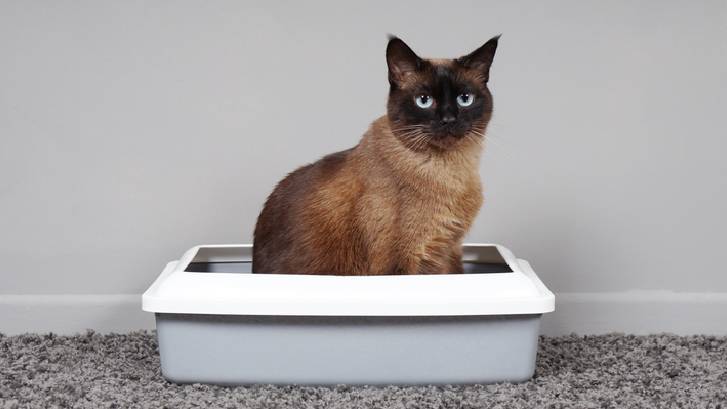Do you know how (and how often) to clean litter boxes?
Do you know how (and how often) to clean litter boxes? Our vet tells you all the do's and don'ts of cat litter box cleaning

If you want to keep your cats healthy and happy, it’s important to understand how, and how often, to clean litter boxes. A dirty litter box can have a number of harmful effects on cats, from both a medical and behavioral standpoint. If you have multiple cats sharing a litter box, a dirty litter box increases the likelihood of disease spreading between your cats. Even if you only have a single cat, a dirty litter box can have negative impacts.
Many cats go out of their way to avoid using a dirty litter box. At best, this could mean that your cat begins peeing or pooping outside of the litter box, developing a house-soiling habit that could be difficult to break. A more serious consequence, however, is that your cat may begin to hold their urine and feces for an abnormal amount of time. Prolonged urine retention can result in feline lower urinary tract disease. Prolonged retention of feces can not only result in constipation, it can also stretch the colon to an unhealthy extent, resulting in a condition called megacolon. In order to prevent these problems, you want to ensure that your cat always has access to a clean and welcoming litter box.
How often should a litter box be scooped?
Conventional, clumping clay litter should be scooped once daily. Use a commercially-available litter scoop to remove all visible clumps of urine and feces from your cat’s litter box on a daily basis. This helps ensure that the litter box remains clean for your cat’s use, while also helping to control odors associated with urine and feces.
How often should you change your cat's litter?
Even if you are scooping daily, you also need to change your cat’s litter on a regular basis. Even the best litter does not clump perfectly, meaning that some amount of urine and feces is always left behind after you scoop your cat’s litter. Over time, this urine and feces contributes to odors within the litter box, which are unpleasant for your cat.
In general, you should completely change your cat’s litter every one to four weeks. If multiple cats are using your litter box, weekly changes may be necessary. In the case of a litter box that is located in a low-traffic area of the home and rarely used, monthly litter changes may be acceptable. Change your cat’s litter as soon as you notice that the litter is beginning to appear “dirty”, even after scooping.

Litter box cleaning hacks
The first step to cleaning a litter box is to empty out all of the old litter. In many cases, the easiest way to do this is to pull a trash bag over the entire litter box (or the lower portion of the litter box, if your box has a lid). Then, gradually lift the litter box out of the bag. This is often a less messy approach than attempting to pour litter into a trash can!
Next, you will need to thoroughly clean your cat’s litter box. Avoid using strong disinfectants or strong-smelling cleaners, because these may be unpleasant for your cat and decrease the chances of them using the litter box after cleaning. Your best option is to clean the litter box with water and gentle dish soap. After thoroughly scrubbing all surfaces of the litter box, set it outside in the sun to dry and “air out.”
Once the litter box is completely dry, you are ready to add new litter to the box. It’s important to know how much litter to put in the litter box. If you use a traditional clumping litter, you should add approximately three inches of litter to the bottom of your cat’s litter box. (If you use a non-clumping litter, you can instead add two inches of litter.) This provides a thick enough layer of litter for your cat to bury their eliminations, while also reducing the likelihood of urine soaking through to the bottom of the box.
Benefits and disadvantages of a self-cleaning litter box
Many owners attempt to avoid daily litter box maintenance by purchasing one of the best automatic litter boxes. There are a number of self-cleaning boxes on the market, including the Litter Robot, the Purina Tidy Cats Litter Breeze System, and the Cat Genie. Some of these litter boxes, like the Litter Robot, use conventional litter combined with an automated scooping feature. These litter boxes contain a reservoir that must be emptied regularly, and also require weekly or monthly cleaning (like a conventional litter box.) Other litter boxes, like the Breeze System, combine specialized pellets with absorbent pads to replace daily scooping, although you will still need to clean the litter box on a regular basis. Finally, systems like the Litter Genie utilize washable granular “litter” and connect to your home’s plumbing, in order to provide a true self-cleaning feature.
Self-cleaning litter boxes have their pros and cons. The pros are probably obvious. Most cat owners find daily litter scooping to be an unpleasant part of cat ownership; eliminating this chore is an appealing option! However, there are also potential drawbacks to these sorts of systems. Obviously, these systems are associated with a higher up-front cost than a conventional litter box. More importantly, however, some cats balk at self-cleaning litter boxes. Many cats prefer clay, clumping litter to pellets or washable granules, which may make them reluctant to use self-cleaning litter boxes that utilize these types of cat litter. Additionally, the scooping or cleaning feature of self-cleaning litter boxes can be noisy, leading cats to be concerned about using the litter box.
If you elect to use a self-cleaning litter box, make sure that your cat still has access to a conventional litter box, at least during the initial transition period. Providing access to a conventional box will reduce the chances of your cat having accidents or developing a medical condition as a result of holding their urine or feces for too long.
Part of responsible cat ownership is knowing how and how often to clean litter boxes. While it’s important to scoop your cat’s litter daily (or use a self-scooping litter box), don’t forget the importance of thoroughly changing the litter and scrubbing your cat’s litter box every few weeks. Keeping your cat’s litter box clean and inviting will reduce the likelihood of accidents and also reduce the likelihood of elimination-related medical issues.
Read next: How to get a cat to use a litter box, our top cat litter hacks and how self-cleaning litter boxes work.
PetsRadar Newsletter
Get the best advice, tips and top tech for your beloved Pets
Dr. Barnette is a graduate of the University of Florida, where she received both her B.S. in Zoology and her Doctor of Veterinary Medicine (DVM). She has 15 years of clinical experience as a small animal veterinarian, treating dogs, cats, and occasional exotic patients. She now works as a freelance veterinary writer, creating educational content for veterinarians, veterinary team members, and dedicated pet owners. Dr. Barnette lives in southwest Florida with her husband and daughter (plus two cats, a dog, and a rescued dove!) and enjoys kayaking, biking, and hiking. Learn more about Dr. Barnette at www.linkedin.com/in/catherinebarnette.

